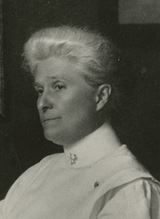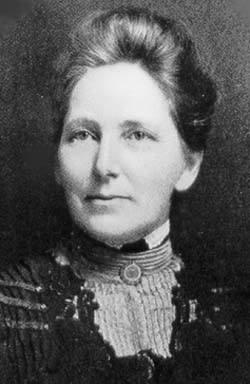
Anna Caroline Maxwell, was a nurse who came to be known as "the American Florence Nightingale". Her pioneering activities were crucial to the growth of professional nursing in the United States.
Myra Louise Taylor was nursing superintendent at St John's General Hospital in Newfoundland from 1916 for more than twenty years. She had been one of the first people to be educated at, and graduate from, the recently founded School of Nursing there. As superintendent she also had responsibility for the School. She had spent two years in London, England doing additional training and became a member of pioneering UK nursing organisations. During her time as superintendent at the St. John's hospital she was made a Fellow of the British College of Nurses.

Lystra Eggert was born in September 1858 in Bayfield, Ontario. She attended grade school in the Bayfield area until 1866 when her family moved to Greensboro, North Carolina. It was here that Lystra began attending private schools. When she was finished with school, at the age of 19, she married a man by the name of John Birney Gretter, where she then took the name, Lystra Gretter. Her husband, John, was approximately twenty six years older and a veteran of the Confederate Army led by Robert E. Lee. In the year 1881, Lystra and John welcomed their first and only daughter, Mary.

Linda Richards was the first professionally trained American nurse. She established nursing training programs in the United States and Japan, and created the first system for keeping individual medical records for hospitalized patients.

St. Luke's International Hospital (聖路加国際病院) is a general and teaching hospital located in the Tsukiji district of Chūō, Tokyo, Japan.
Bertha Harmer was a Canadian nurse, writer and educator, known for writing the textbook Textbook of the Principles and Practice of Nursing.

The Iloilo Mission Hospital, commonly referred to as Mission Hospital, Mission, CPU–IMH or IMH, is a private tertiary, academic and teaching hospital located in Jaro, Iloilo City, Philippines. Established in 1901 through the auspices of the Presbyterian Foreign Mission Board from the United States by the American missionary doctor, Joseph Andrew Hall, it is the "first and oldest American and Protestant founded hospital in the Philippines". In 1905, it was named Sabine Haines Memorial Union Mission Hospital through a grant from Charles Haines, a New Yorker, in honor of his son.

The United States Army Nurse Corps (USANC) was formally established by the U.S. Congress in 1901. It is one of the six medical special branches of officers which – along with medical enlisted soldiers – comprise the Army Medical Department (AMEDD). The ANC is the nursing service for the U.S. Army and provides nursing staff in support of the Department of Defense medical plans. The ANC is composed entirely of Registered Nurses (RNs).
Nursing in India is the practice of providing care for patients, families, and communities in that nation to improve health and quality of life.
Nursing in Japan did not develop as an occupation until the end of the nineteenth century. Initially introduced only in Tokyo in the late 1860s, small schools utilizing Western models were being opened by the late 1880s. In response to disaster relief, the Japanese Red Cross became an integral part of nursing development. By 1915, nurse registration had been established and public health nurses began working throughout the country. Nursing universities were established in the twentieth century and regulations were passed to develop standards for training and public health.

John McKim was an American missionary who became Anglican Bishop of Tokyo and Chancellor of Rikkyo University, which was part of the infrastructure he helped rebuild after a severe earthquake in 1923.

Rudolf Bolling Teusler M.D. was a medical physician and lay missionary to Japan who worked under the auspices of the Foreign and Domestic Missionary Society of the American Episcopal Church.

Victoria Joyce Ely was an American nurse who served in World War I in the Army Nurse Corps and then provided nursing services in the Florida Panhandle in affiliation with the American Red Cross. To address the high infant and maternal death rates in Florida in the 1920s, she lectured and worked at the state health office. Due to her work, training improved for birth attendants and death rates dropped. After 15 years in the state's service, she opened a rural health clinic in Ruskin, Florida, providing both basic nursing services and midwife care. The facility was renamed the Joyce Ely Health Center in her honor in 1954. In 1983, she was inducted into Florida Public Health Association's Hall of Memory and in 2002 was inducted into the Florida Women's Hall of Fame.
Louie Croft Boyd was an American nurse, hospital superintendent of nurses, nursing instructor, and writer. As a lobbyist for the newly formed Colorado State Trained Nurses Association, she advocated for legislation to regulate the licensing of nurses in Colorado. Upon passage of the bill in 1905, she applied for and became the first licensed nurse in the state. She was posthumously inducted into the Colorado Nurses Association Hall of Fame and the Colorado Women's Hall of Fame in 2004.

Carrie May Hall was a nurse who held several senior leadership positions in hospitals and within the American Red Cross during the First World War.
Nora Neve (1873-1952) was a British nurse and medical missionary with the Church Missionary Society who pioneered missionary nursing. Her work was instrumental in the development of the Kashmir Mission Hospital in Srinagar. She was the hospital's first Superintendent of Nursing and led education and cleanliness initiatives. Neve also recorded and published records of Kashmiri hospital practices in the American Journal of Nursing, contributing to the tool kits of other missionaries and preserving a part of Kashmir's cultural history.
Louise M. Powell (1871–1943) was an American nurse and educator who led the University of Minnesota School of Nursing, during its formative years. During her tenure there (1910–1924), the university established a five-year baccalaureate nursing degree program. In honor of her achievements, the nurses residence hall was named for her in 1939. She was later dean of nursing at Western Reserve University.
Flora Madeline Shaw was a Canadian nurse and nursing teacher. She began her career as second and later first assistant to the Montreal General Hospital Training School for Nurses's superintendent before becoming matron of the Presbyterian Hospital in New York City. Shaw was the first Director of the McGill School for Graduate Nurses in Montreal; she was president of each of the Canadian Association of Nursing Education, the Association of Registered Nurses of the Province of Quebec and the Canadian Nurses Association. A memorial fund scholarship, a memorial tablet and the Chair of Nursing at McGill University were all dedicated to her.

Sophia French Palmer was an American nurse, an editor and a health administrator. She was the first Editor-in-chief of the American Journal of Nursing. She was the President of the New York State Board of Nurse Examiners. She was also associated with the American Nurses Association, and various American Training Schools for Nurses including the Garfield Memorial Hospital. She made significant contributions in establishing a number of health institutions particularly in the field of nurse training.












